
Engemen
Located south of the town of Bonn, Germany, and designed by engineer Karl Weiner to help bring troops to the Western Front during WWI (it is named for its leading proponent, General Erich Friederich Wilhelm Ludendorff) the railroad bridge is built by the construction companies of Grun & Bilfinger and MAN-Werk Gustavsburg (supplemented by Russian prisoners of war) at a cost of 2.1 million marks. Started in 1916 and fully completed in 1919, the structure weighs 5,110 tons, at normal water levels, stands 48 feet above the Rhine River (at is highest arch, 94 feet above the water), has a length of 1,306 feet, and consists of three spans (the center section is 512 feet long) that carry two railroad lines and two catwalks on either side (planks made to fit over the tracks allow for vehicular movement across the span) ... and since it is originally created for military purposes, the structure includes four large stone towers (two on either end), with fighting loopholes, room enough to shelter a battalion of soldiers, and special wiring connections designed to set off as many as 60 explosive charges at once to simplify bringing the span down if its destruction should prove necessary ... steel, wood, concrete, and stones ... it is strong and very sturdy structure.
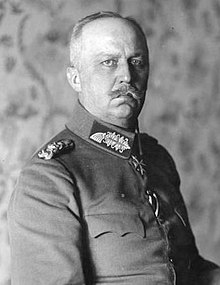
Namesake
American Troops Crossing - 1918

Ludendorff Bridge - March, 1945
The men assigned to protect or blow the bridge are problematic however as responsibility shifts from Waffen SS troops of the military district, to members of the Germany Army, while the anti-aircraft guns on both sides of the river report to the Luftwaffe air command. On 3/5, two days before the bridge will be battled for, the span is guarded by only 36 soldiers, most of them convalescents trying to recover from their wounds and ease back into military service, a few engineers, and the anti-aircraft crews. Further making the area's defense difficult, Lt. Walter Hugo Botsch only becomes responsible for the region on 3/1, and is then transferred again on 3/6 (and so is unable to come through on his promise to provide the combat commander of the bridge, Captain Willi Bratge, more soldiers, equipment, and anti-aircraft personnel), so quickly that he does not have time to advise his replacement, Generalmajor Richard von Bothmer, on defensive dispositions around the bridge (and the officer Bothmer sends to Remagen as a liaison before his arrival at the bridge is captured by rapidly advancing Americans). Command chaos, General Edwin Graf von Rothkirch und Trach, commanding officer of the LIII Armeekorps responsible for the area, becomes another German POW on 3/6. In the midst of that confusion, General der Infanterie Otto Maximilian Hitzfeld, is not told until 1:00 in the morning that the Ludendorff Bridge is now his problem ... dispatched by Hitzfield to take command at the bridge, Major Hans Scheller leaves for Remagen at 3:00 in the morning on a 40+ mile journey of dodging American tanks and trying to procure gasoline ... he arrives the next day shortly before noon, less than two hours before American forces also arrive at Remagen. And last, but certainly not least of the German problems around the bridge, are those supplied by the leader of Nazi Germany, Adolph Hitler. Paranoid and fearful, the men are told to blow the bridge should Americans arrive in the area ... but not too early ... mixed signals in which the defenders could be executed for bringing down the structure prematurely (as with the court-martials that follow a bridge at Cologne coming down too early), or for not bringing it down at all. Gauging enemy activity in the area, the Germans schedule the bridge to come down at 4:00 in the afternoon.

Rothkirch (At Front) In American Custody

Hitzfeld
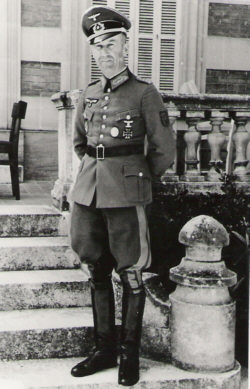
Botsch

von Bothmer
Scheller With His Daughter
Moving forward as part of Operation Lumberjack (to seize control of the west bank of the Rhine River), scouts of the American 89 Reconnaissance Squadron arrive on a hill overlooking Remagen at 12:56 in the afternoon and immediately realize the opportunity they have in capturing an intact bridge over the Rhine ... information that rapidly moves up the chain of command from Lieutenants Karl Timmermann (born in Frankfurt, Germany) and John Grimbull, to Engemen, to Operations officer Major Ben Cothran, to Brigadier General William M. Hoge, commanding officer of Combat Command B of the 9th Armored Division, and after discussing the situation, Timmermann is given a green light to try to take the bridge. At 1:50, American troops begin advancing into Remagen, supported by 17 tanks, and at 3:00 are in position to attack the bridge (the only major resistance to the move comes from a machine gun located in the town square which is quickly silenced by two Pershing tanks) ... defending the area is a mixed bag of soldiers, men recovering from injuries, and Engineering company of 125 men, 180 members of the Hitler Youth, 200 Luftwaffe personnel, 20 men of a rocket battery, 120 Eastern "volunteers," and 500 civilians belonging to the local Volkstrum militia, about 1,000 men.
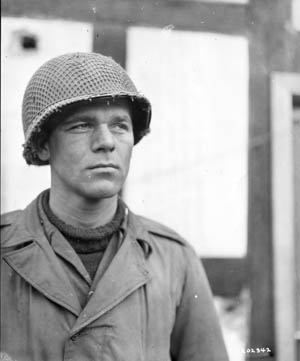
Timmermann

Hoge
Bridge Layout
Calling for artillery fire to create a smoke screen to mask his unit's movements, Timmermann's men move forward as the Major Scheller decides it is time to blow the bridge ... but there is a problem, before Captain Karl Friesenhahn (the officer in charge of the demolitions on the bridge) can do that, he agrees to a delay of minutes so a unit testing a top secret rocket launcher system can get to safety ... ready to blow, before Friesenhahn can set off the explosives, he is knocked unconscious by an exploding shell ... recovered 15 minutes later though, he demands written orders from first Scheller, and then from Bratge before he will hit the electric switch controlling the detonators. Paperwork finally received, at 3:20, Friesenhahn makes a last connection and turns the handle that should send the bridge into the Rhine ... but nothing happens (it is thought that American artillery has severed a connection in the line, or POW work on the system has sabotaged a link in the line). Plan B required, Corporal Anton Faust volunteers to run through enemy fire to manually light a primer cord to set off the charges. At 3:50, as Americans swarm across the bridge, the explosives go off ... but when the smoke and dust clears, the bridge is still standing (not enough explosives, and explosives of a lower grade have not provided enough punch) ... there are large holes in the planking covering the railroad ties, some steel supporting girders are twisted, and there is a 30 foot gap in the truss keeping up the southern side of the structure, but the bridge is still viable. Some men attacking, some cutting wires and throwing explosives into the river, the Americans move across the Ludendorff bridge and gain the other side of the river ... winning the Distinguished Service Cross, first over is 35-year-old former butcher, Sgt. Alexander A Drabik of Lucas County, Ohio (other than for a pause when the Germans set off their explosion on the bridge, he runs the entire length of the structure until reaching its eastern side), the first enemy soldier to cross the Rhine and capture a part of Germany since the Napoleonic Wars of the early 1800s (the first Allied newspaperman into the area is future 60 Minutes star, Stars and Stripes combat correspondent, Andy Rooney).

U.S. Army Painting - The Battle Of Remagen Bridge
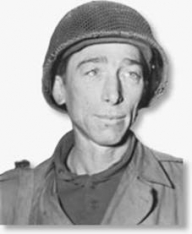
Drabik
Southern Side Damage

Taken!

Bridge Kings!
Bridge somehow taken (2,260 pounds of unexploded demolition charges will be discovered on the bridge after the structure is taken), the battle however has just begun as both sides move more manpower into the area. Hitler, livid that his specific orders on blowing the bridge have not been followed, orders attack after attack after attack on the span, and in ten days, the Ludendorff Bridge is assaulted by German infantry, tanks, howitzers, mortars, floating mines, mined boats, a giant 540mm super-heavy mortar (that fires a shell weighing 4,780 pounds), new Arado Ar 234 B-2 turbojet bombers (of the estimated 400 different Luftwaffe planes that participate in attacks on the bridge, American anti-aircraft fire knocks down roughly 30%), V2 rockets (the first time the missile is used as a tactical weapon ... six Americans and a number of German civilians are killed, but the bridge is missed entirely), and a squad of seven naval demolition swimmers (all are killed or captured when American forces deploy for the first time in combat top-secret Canal Defence Lights, with a candlepower of 13 million, to detect the enemy frogmen in the dark). Already weakened, hit again and again, to the horrifying sound of tearing steel, the Ludendorff Bridge finally crashes into the Rhine River on 3/17/1945 at about 3:00 in the afternoon, while about 200 engineers and welders are working on the structure (28 men are killed and another 63 injured in the collapse).

Remagen And Its Bridge
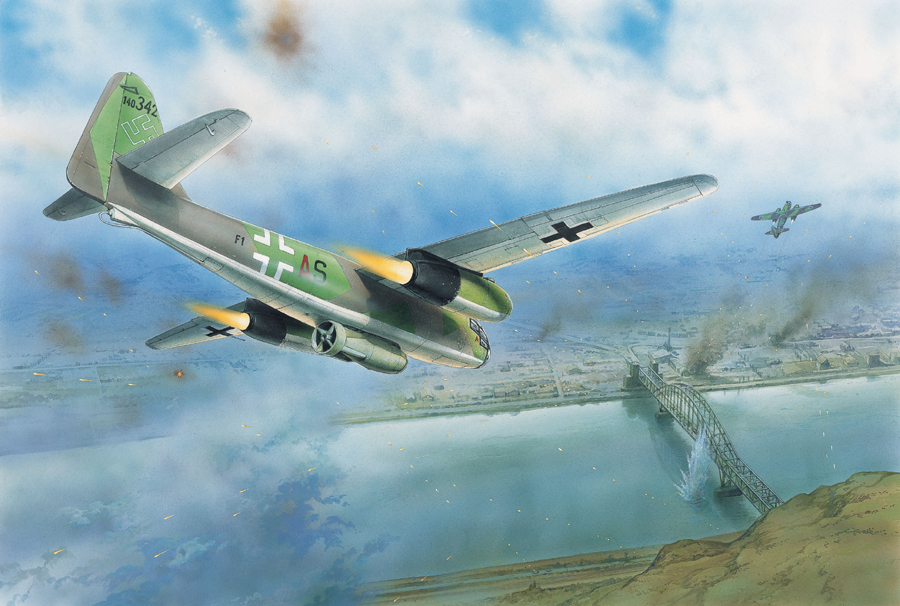
Air Attack
The Bridge Goes In
Down
But the bridge's destruction is too late! Using the Ludendorff Bridge, and several additional temporary bridges built by combat engineers, the American Army is able to establish a bridgehead eight miles deep and roughly twenty-five miles wide of roughly 25,000 soldiers on the eastern bank of the Rhine River. On 3/24, in support of General Patton also bringing his command over the Rhine, the force attacks into Germany, participating in the advance that will end the war in Europe by May 7th. Taking the bridge has shortened the war by several months, and saved the lives of an estimated 25,000 to 50,000 Allied soldiers!

Patton Pissing In The Rhine
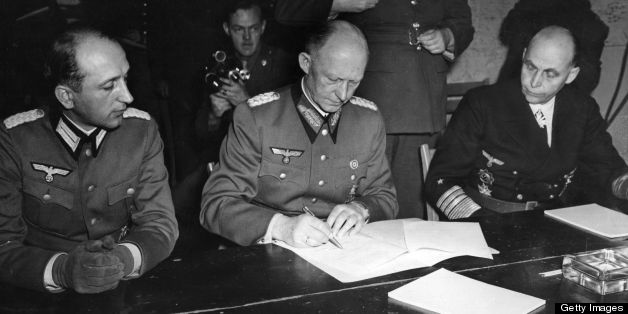
The German Surrender - 5/7/1945
Defeated in battle, defeated in the war, for a handful of Germans the ultimate price will have to be paid for failing to destroy the bridge. Summoned from the Eastern Front, Hitler appoints Generalleutnant Rudolf Hubner to court-martial and execute all officers responsible for the failure ... a typical Nazi kangaroo court of the time, Bratge and Friesenhahn are sentenced to death in absentia (saving their lives, both men have been taken prisoner by the Americans at the bridge), and in a needless waste of lives, Scheller, though only arriving at the site a few hours before the Americans attack, and Lt. Karl Peters (the Luftwaffe officer that delays the bridge's destruction and then allows his top secret anti-aircraft weapon to fall into enemy hands) are found guilty of cowardice and dereliction of duty and executed, as are Major Herbert Strobel and Major August Kraft, the officers in charge of the first failed counterattack against the American bridgehead (shot in the back of their heads after a twenty minute trial). Additionally, Generalmajor Richard von Bothmer (his wife dead and son killed in the war), in command of the Bonn and Remagen region, is reduced to the rank of private and sentenced to five years in prison ... but avoids prison time by grabbing a pistol from a court official and killing himself on March 10th.

Hubner

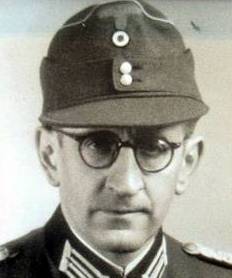


Peters & Strobel
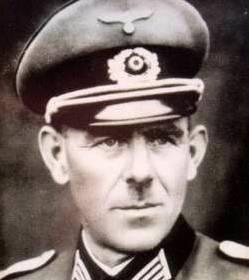
Kraft
The Scheller Execution
Bridge never rebuilt after the war, the towers on the western side of the Rhine are now open to the public as the Remagen Bridge Peace Museum, while in 2006, the eastern towers and the railroad tunnel leading to them are made into a performance space for local artists (the village of Erpel celebrates the 1,500 year anniversary of its founding in 1968). And in a nearby cemetery at Birnbach, Germany, a memorial honors the four men executed for not putting the Ludendorff Bridge in the Rhine River.

Memorial Plaques At The Bridge Site
Birnbach Memorial
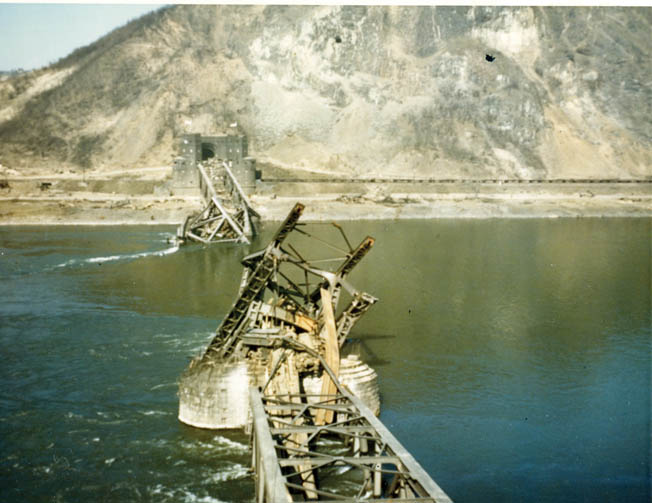
Rhine River At Remagen - After The War

Post War

Post War
Bridge Area

Present Day
Present Day
3/7/1945 - Once upon a time at the Ludendorff Bridge!
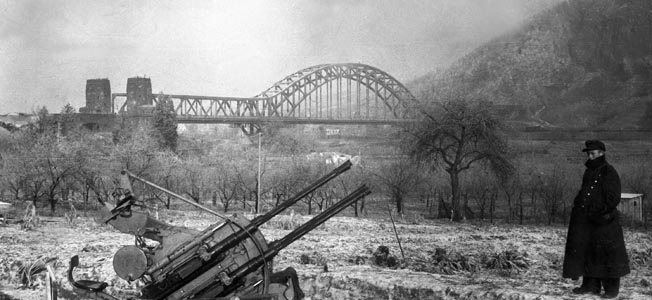
No comments:
Post a Comment